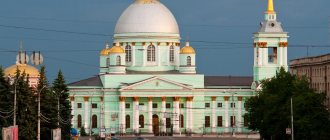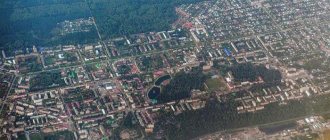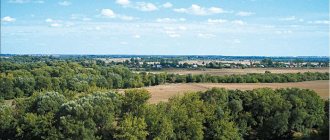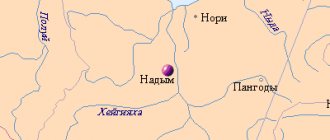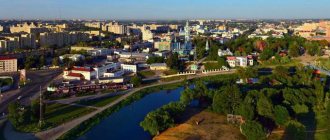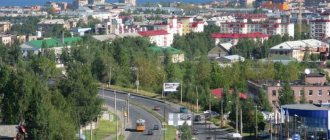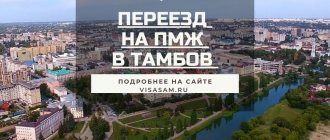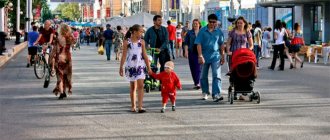- July 27, 2019
- Directions
- Molton
Kirov is a regional center in the northeast of the European part of Russia. Where is Kirov? The city is located 896 km northeast of Moscow, on the Vyatka River. It is the administrative center of the Kirov region. The number of inhabitants is 512,954 people. This is the industrial, scientific and cultural center of the Urals. A city with a long history. It dates back to 1181. It was the easternmost city of Ancient Rus'.
Kirov is divided into 4 districts. The height of the central part is 150 meters. The head of the city is Elena Vasilievna Kovaleva.
Geographical features
Many people are interested in the question: where is the city of Kirov? This regional center is located in the valley of the Vyatka River, in the middle part of its course, on the Russian Plain. Part of the Volga Federal District. Located in the taiga forest zone. Kirov is located in the Moscow time zone.
The climate is determined by where the city of Kirov is located. It's continental and cool. Characterized by frequent incursions of cold air masses from the Arctic Ocean located in relative proximity. Therefore, severe frosts are common in winter, and sudden cold snaps in summer. The city itself is noticeably warmer than the surrounding area. Annual precipitation is 677 mm. Most of them fall in the summer.
Within the city limits there are agricultural lands and specially protected natural areas.
Vladimir
An ancient city, which is one of the five most visited cities of the Golden Ring of Russia. In Vladimir, you can touch history by visiting architectural monuments that have been preserved since the times of Kievan Rus. It is the architectural structures that are the main attractions of the city. The oldest monuments, dating back to the times of pre-Mongol Rus', are the Assumption and Demetrius Cathedrals. The Assumption Cathedral - the cathedral of the Vladimir diocese - is also a state museum. Within the walls of this cathedral the princes of Vladimir and Moscow were married for their great reign. This is one of the few monuments where frescoes by Andrei Rublev have been preserved. At the end of the last century, the cathedral was included in the list of UNESCO World Heritage Sites. Dmitrievsky Cathedral is also included in the UNESCO list. It is notable for its white stone carvings - its walls are decorated with hundreds of reliefs with images of saints, real and mythical animals; on each façade, King Solomon is depicted in the center of the composition. The exhibition “A Unique Monument of White Stone Architecture” is open in the cathedral premises. Another Vladimir UNESCO monument is the Golden Gate. They were built in 1164 under Prince Andrei Bogolyubsky. In addition to its defensive function, the gate had a triumphal meaning - it was the main entrance to the rich princely part of the city. Nowadays the museum of military valor is located in the gate premises.
In general, there are many museums in Vladimir: military themed, historical, a crystal museum and others. Here you can also get acquainted with unusual monuments to Vladimir the Red Sun, Andrei Rublev and others. You can stroll through Vladimir parks and look at the beautiful landscape of the Klyazma River. Traditionally, tourists in Vladimir go outside the city to the village of Bogolyubovo to see the famous historical and architectural monument - the Church of the Intercession of the Nerl.
Ecological problems
The main air pollutants in Kirov are industrial enterprises. The most common pollutants are carbon monoxide, dust and formaldehyde. The quality of water in the Vyatka River does not meet accepted standards. The main water pollutants are enterprises and household wastewater. The Institute of Microbiology of the Ministry of Defense of the Russian Federation has highly dangerous strains of viruses, which, in the event of an emergency, may be released.
Cheboksary
Previously, Cheboksary was considered the capital of brewing in Russia. Nowadays, of course, few people grow hops here, but there is a “Beer Museum” and it’s worth a look. This city also has its own Red Square - the main square of the city, where all the mass celebrations take place. The townspeople are proud of their parks – the “Guzovsky Grove”, conceived as the center of the cultural and recreational life of the city, where hundred-year-old oak trees grow today, among which townspeople love to walk and play sports. Another park is the Victory Memorial Park - a great place for a walk. Of particular note is the Central Park of Culture and Recreation “Lakreevksiy Les”, which is recognized as an all-Russian natural monument. This city, like others, has its own embankment, on the territory of which various monuments are located. Having visited Chuvashia, it is worth visiting the city of Novocheboksarsk, near which the Cheboksary hydroelectric power station is located on the Volga River. It forms the Cheboksary reservoir and is part of the Volga cascade of hydroelectric power stations. This is one of the largest hydroelectric power stations in Russia, with a capacity of 1,404 megawatts.
One of the main attractions of Cheboksary is the composition dedicated to the Patroness Mother of the Chuvash people, erected on the shore of the Cheboksary Bay. The size of the structure is striking in its majesty - together with the pedestal, its height is 46 meters. Not far from Kirov, within a radius of only 1000 kilometers, there are hundreds of other interesting places, from visiting which you can get a lot of impressions. Among them is Kazan with a water park, the Kul-Sharif mosque and the “leaning” Syummbike tower. This is Nizhny Novgorod with its historical buildings, including the Nizhny Novgorod Kremlin and the Pechersky Monastery. And other cities - Ivanovo, Ryazan, Orenburg, Moscow, Penza, Saransk, Perm... In each region there are many settlements, cities, towns and villages that have their own attractions - architectural, historical, natural monuments. At the same time, you can go to many of these places without waiting for a long vacation, but by choosing only 2 days off. The vacation, at the same time, will be no worse than a foreign or southern one.
Population of Kirov
The city's population grew rapidly during the Soviet era, stabilized in the 1990s, and then began to grow again. At the moment, moderate growth continues. In the list of cities of the Russian Federation, Kirov ranks 37th in terms of the number of inhabitants. Representatives of the female sex in Kirov are 56%. Among the residents, 96.6% are Russian. In second place are Tatars with a share of 0.79%, and in third place are Ukrainians (0.57%). The share of the working-age population is 63%. 237.9 thousand people officially work.
There is a large proportion of elderly people in Kirov. This is largely due to the fact that young people are actively leaving. Mostly they go to St. Petersburg or abroad. Residents of Kirov are distinguished by their friendliness.
Map
| Kirov: maps |
Kirov: photo from space (Google Maps) Kirov: photo from space (Microsoft Virtual Earth)
| Kirov. Nearest cities. Distances in km. on the map (in brackets along roads) + direction. Using the hyperlink in the distance , you can get the route (information courtesy of the AutoTransInfo website) | |||
| 1 | Murygino | 19 (31) | NW |
| 2 | Kirovo-Chepetsk | 22 (36) | IN |
| 3 | Vakhrushi | 23 (23) | NE |
| 4 | Slobodskaya | 33 (33) | IN |
| 5 | Orichi | 40 (44) | SW |
| 6 | Orlov | 45 (72) | Z |
| 7 | Yurya | 53 (61) | NW |
| 8 | Pervomaisky | 56 () | WITH |
| 9 | Kumeny | 56 (67) | YU |
| 10 | White Kholunitsa | 73 (72) | IN |
| 11 | Verkhoshizhemye | 73 (77) | SW |
| 12 | Kotelnich | 83 (119) | SW |
| 13 | Suna | 88 (88) | YU |
| 14 | Zuevka | 89 (109) | IN |
| 15 | Murashi | 95 (109) | NW |
| 16 | Darovskaya | 98 (177) | Z |
| 17 | Nagorsk | 102 (118) | NE |
| 18 | Bogorodskoye | 107 (125) | SE |
| 19 | Fallonki | 115 (139) | IN |
| 20 | Nolinsk | 117 (132) | YU |
| 21 | Sovetsk | 120 (129) | YU |
a brief description of
Located on the banks of the river. Vyatka (port), stretching along it for 25 km, 896 km east of Moscow. Large railway junction lines and highways.
In 1970, Kirov was included in the list of historical cities of Russia. The urban planning value of its heritage is assessed at the regional level. In 2010, it was excluded from the list of historical cities.
The climate is moderate continental. Average temperatures in January are -15, July are +18. Precipitation is about 550 mm per year.
Data on the population of Kirov sometimes include 25 thousand people. rural population, 22 thousand people. PGT, subordinate to the city administration, which gives a number of 510 thousand people.
Territory (sq. km): 757
Information about the city of Kirov on the Russian Wikipedia site
Historical sketch
It was first mentioned in 1374 as the city of Vyatka; name by location on the river Vyatka.
In 1455 in Vyatka, at the mouth of the river. Khlynovitsa built a kremlin, called Khlynov. The modern form of the hydronym suggests its formation from the name Khlynov, and at its basis one can see the nickname Khlyn (Vyatka khlyn “fraudster, deceiver, profit dealer”). Based on the name of the Kremlin, the entire city soon began to be called Khlynov, although along with this name the name Vyatka continued to be used.
At the end of the 14th century. was in the possession of the Suzdal-Nizhny Novgorod, at the beginning of the 15th century. - Galician princes. From the middle of the 15th century. known as a local center of crafts and trade. Annexed to the Moscow State in 1489.
The city was formed around a fortress standing on the high bank of the Vyatka River (late 14th - early 15th centuries, fortified with ramparts and chopped wooden walls in the middle and second half of the 17th century).
Since 1708, the city of Khlynov has been part of the Siberian province, since 1719 the center of the province. Since 1727, Khlynov has been in the Kazan province, the center of the province. In 1780, the Vyatka governorate was formed (from 1796 - the Vyatka province), Khlynov, renamed Vyatka, became its center.
In the 18th century Manufacturing production was developed, distilleries, leather and fur factories, shoe factories, and sawmills operated. 2 annual fairs were held. In the 18th century the first educational institutions appeared, incl. theological seminary and public school.
Vyatka is known as a place of political exile. Here she was served by A.I. Herzen, M.E. Saltykov-Shchedrin et al.
In 1856, in the provincial city of Vyatka, Vyatka province, there were 21 churches, 1036 houses, 219 shops.
Since 1929, Vyatka has been part of the Nizhny Novgorod region. Since 1934 the center of the Kirov region. Renamed Kirov in 1934, in honor of the Soviet party leader S.M. Kirov (1886-1934), a native of the Vyatka province. Since 1936 - the center of the Kirov region.
On June 1, 1959, the village of Kominternovsky was included within the city limits (PGT since 1939).
In 1989, the city of Novovyatsk was included in its composition as the Novovyatsky urban district (city since 1955, 19.5 thousand inhabitants, 1959; 26.4 thousand inhabitants, 1970; 31.9 thousand inhabitants, 1979; 37.9 thousand inhabitants. , 1989). On March 28, 1955, the working villages of Vyatsky (PGT since 1945) and Lesozavodsky (PGT since 1939, 3.4 thousand inhabitants, 1939) were united into one village which was transformed into the city of Novovyatsk.
Municipal indicators
| Index | 1990 | 1999 | 2001 | 2003 | 2005 |
| Demography | |||||
| Number of births, per 1000 population | 11.7 | 7.1 | 8.1 | 9.2 | 9.2 |
| Number of deaths, per 1000 population | 9.6 | 13.6 | 13.9 | 16.2 | 15.7 |
| Natural increase (decrease), per 1000 population | 2.1 | -6.5 | -5.8 | -7 | -6.5 |
| Standard of living of the population and social sphere | |||||
| Average monthly nominal accrued wages, rub. | 0.304 | 1377 | 2778 | 4690 | 7366 |
| Average housing area per inhabitant (at the end of the year), sq.m. | 15.6 | 18.6 | 18.9 | 19.4 | 20 |
| Number of preschool institutions, pcs. | 249 | 135 | 132 | 130 | 129 |
| Number of children in preschool institutions, thousand people | 36.3 | 18.1 | 18.7 | 19.2 | 21 |
| Enrollment of children in preschool educational institutions (at the end of the year), as a percentage of the number of children of the corresponding age, % | 83.5 | 86.2 | |||
| Number of daytime educational institutions (at the beginning of the school year), pcs. | 72 | 89 | 91 | 82 | 79 |
| Number of students in daytime educational institutions, thousand people | 61.2 | 64.2 | 57.6 | 49.6 | 42.9 |
| Number of doctors, people. | 2838 | 3953 | 3970 | 4107 | 4028 |
| Number of nursing staff, people. | 6494 | 7630 | 7537 | 7579 | 7450 |
| Number of hospital institutions, pcs. | 28 | 32 | 32 | 30 | 30 |
| Number of hospital beds, thousand units | 10.2 | 9.6 | 9.4 | 9.2 | 8.9 |
| Number of medical outpatient clinics, pcs. | 50 | 60 | 65 | 89 | 100 |
| Capacity of medical outpatient clinics, visits per shift, thousand units. | 13.1 | 12.3 | 12.6 | 12.9 | 13.3 |
| Number of registered crimes, pcs. | 6480 | 11103 | 12582 | 11794 | 16405 |
| Persons who committed crimes were identified, persons. | 2613 | 4724 | 4062 | 3153 | 4466 |
| Economy, industry | |||||
| Number of enterprises and organizations (at the end of the year), pcs. | 11915 | 14354 | 17264 | 20931 | |
| Number of operating enterprises by type of activity: mining (at the end of the year), pcs. | 5 | ||||
| Number of operating enterprises by type of activity: manufacturing (at the end of the year), pcs. | 464 | ||||
| Number of operating enterprises by type of activity production and distribution of electricity, gas and water (at the end of the year), pcs. | 109 | ||||
| Volume of shipped goods of own production by type of mining (in actual prices), million rubles. | 24.6 | ||||
| Volume of shipped goods of own production by type of manufacturing (in actual prices), million rubles. | 22660.3 | ||||
| Volume of shipped goods of own production by type of production and distribution of electricity, gas and water (in actual current prices), million rubles. | 10974.7 | ||||
| Construction | |||||
| Volume of work performed by type of activity “Construction” (until 2004 - volume of work performed under construction contracts), million rubles. | 662.9 | 1062.5 | 1575.4 | 2116.7 | |
| Commissioning of residential buildings, thousand sq.m. of total area | 206.6 | 128 | 106.2 | 89 | 157.1 |
| Commissioning of residential buildings, apartments | 1974 | 1691 | 1338 | 2422 | |
| Commissioning of preschool institutions, places | 635 | 0 | 0 | 0 | 0 |
| Commissioning of educational institutions, places | 1251 | 0 | 0 | 0 | 0 |
| Commissioning of hospital facilities, beds | 90 | 0 | 0 | 70 | 0 |
| Commissioning of outpatient clinics, visits per shift | 125 | 48 | 200 | 380 | 250 |
| Transport | |||||
| Number of bus routes (in intracity traffic), pcs. | 52 | 47 | 24 | 9 | |
| Number of trolleybus routes, pcs. | 9 | 11 | 12 | 10 | |
| Length of operational trolleybus lines (at the end of the year), km | 50.1 | 47.9 | 47.9 | ||
| Number of passengers transported by buses per year (in intracity traffic), million people. | 161.3 | 149.9 | 154.9 | 103 | 10.5 |
| Number of passengers transported by trolleybuses per year, million people. | 85.6 | 125.7 | 143.1 | 150.4 | 35.7 |
| Connection | |||||
| Number of telephone sets of the city public telephone network, thousand units. | 71.8 | 136 | 152.7 | 177.2 | 199.4 |
| Number of residential telephone sets of the city public telephone network, thousand units. | 38.1 | 99.5 | 113 | 135.2 | 150.7 |
| Number of payphones of the city telephone network (including universal ones), pcs. | 1363 | 1217 | |||
| Trade and services to the population | |||||
| Retail trade turnover (in actual prices), million rubles. | 0.857 | 5504.4 | 8037 | 12442.2 | 17897.4 |
| Retail trade turnover (in actual prices), per capita, rub. | 1.739 | 10911 | 15651 | 24894 | 36355 |
| Index of physical volume of retail trade turnover, % compared to the previous year | 100 | 111.8 | |||
| Index of physical volume of public catering turnover, % compared to the previous year | 96.5 | 94.4 | |||
| Number of stores, pavilions (at the end of the year), pcs. | 245 | 227 | |||
| Sales area of shops, pavilions (at the end of the year), sq.m. | 38122 | 48840 | |||
| Volume of paid services to the population (in actual prices), million rubles. | 0.252 | 1787 | 3308 | 5555.3 | 9052.6 |
| Volume of paid services to the population (in actual prices), per capita, rub. | 0.5 | 3542 | 6443 | 11115.1 | 19744 |
| Volume of household services to the population (in actual prices), million rubles. | 0.069 | 849.7 | 825.7 | 1091.4 | 1617.4 |
| Volume of household services to the population (in actual prices), per capita, rub. | 0.1 | 1684 | 1608 | 2183.6 | 3528 |
| Investments | |||||
| Investments in fixed assets (in actual prices), million rubles. | 0.412 | 1665.6 | 2635.1 | 4409.1 | 7857.9 |
| Share of investments in fixed assets financed from budgetary funds in the total volume of investments, % | 25.9 | 27.1 | 23.3 | 27.8 | |
Data sources:
- Regions of Russia. Main characteristics of the constituent entities of the Russian Federation: statistical collection. Goskomstat of Russia. - M:, 2003.
- Regions of Russia. Basic socio-economic indicators of cities. Statistical collection. Rosstat. - M:, 2005. p. 227
- Transport in Russia: Statistical collection. Goskomstat. - M:, 2003. pp. 112, 122
- Transport in Russia: Statistical collection. Rosstat. - M:, 2005. pp. 119, 129
- Regions of Russia. Basic socio-economic indicators of cities. 2006. Statistical collection. Rosstat. - M:, 2006. p. 231
Culture, science, education
Institutes: pedagogical, agricultural, polytechnic. Faculty of the All-Russian Correspondence Institute of Finance and Economics, branch of the Perm Medical Institute.
Theatres: drama, puppet theaters, young spectators.
Kirov United Museum: Museum of Local Lore, Art Museum named after V.M. I am. Vasnetsov (opened in 1910 in a building of the early 19th century, architect I. Dusor de Neuville).
Museums: M.E. Saltykova-Shchedrina, A.S. Green (studied in Vyatka), aviation and astronautics named after K.E. Tsiolkovsky, “Vyatka artistic crafts”.
Architecture, sights
The old part of the city is picturesquely located on the steep left bank of the Vyatka River.
Since 1784, the development of the city was carried out according to a regular plan. In the central part there is a rectangular grid of streets.
To the south of the former fortress, on the slope of the Zasorsky ravine - the Trifonov Monastery with the 5-domed Assumption Cathedral (1684-89), the elegant gateway St. Nicholas Church (1690-95), the abbot's building and cells (1719), the Annunciation (1728) and the Three Saints ( 1717) churches with rich relief patterns on the walls. To the north of the former fortress is the ensemble of the Spaso-Preobrazhensky Novodevichy Convent (founded in 1624) with the elegant stone Church of the Transfiguration of the Transfiguration (1696), to the northwest is the Posad Church of John the Baptist (1st half of the 18th century, rebuilt in the 18th and 19th centuries).
On the territory of the old center, the building of the former Chamber of Orders (1740-70s, rebuilt), two buildings of the Government Offices (1787-90) in the classicist style have also been preserved. The buildings in the city garden (1835-39, architect A.L. Vitberg) have been preserved. In the southern part according to the project of A.L. Vitberg built the huge Alexander Nevsky Cathedral (1838-48).
At the end of the 18th century. - first half of the 19th centuries. Numerous buildings were built in the classicist and empire style - according to the designs of F. Roslyakov, I. Dosur de Neuville and others. At the end of the 19th century. local architect I.A. built a lot. Charushin - eclectic shopping arcades, lush mansions, wooden residential buildings with solid carvings, administrative buildings.
In the Zarechensky district of Kirov (formerly the settlement of Dymkovo) - the production of traditional molded toys (“Dymkovo”; figurines of ladies in crinolines, hussars, whistles in the form of animals, horsemen, etc.) from clay calcined in an oven with multi-color tempera painting on white ground. In the village of Makarye (near Dymkovo) there is an elegant Baroque Trinity Church (1770-75).
| Population by year (thousands of inhabitants) | |||||||
| 1811 | 4.2 | 1956 | 211 | 1996 | 464.8 | 2012 | 478.0 |
| 1840 | 11.0 | 1959 | 252.4 | 1998 | 465.9 | 2013 | 483.2 |
| 1856 | 15.5 | 1962 | 277 | 2000 | 466.2 | 2014 | 487.1 |
| 1863 | 14.7 | 1967 | 309 | 2001 | 466.8 | 2015 | 493.3 |
| 1897 | 25.0 | 1970 | 332.5 | 2003 | 457.6 | 2016 | 497.0 |
| 1913 | 46.4 | 1973 | 357 | 2005 | 448.5 | 2017 | 501.5 |
| 1914 | 47.0 | 1976 | 378 | 2006 | 468.5 | 2018 | 507.2 |
| 1923 | 52.3 | 1979 | 389.5 | 2007 | 466.3 | 2019 | 513.0 |
| 1926 | 61.2 | 1982 | 400 | 2008 | 464.6 | 2020 | 518.3 |
| 1931 | 73.5 | 1986 | 415 | 2010 | 463.9 | 2021 | 521.1 |
| 1939 | 143.6 | 1989 | 440.2 | 2011 | 473.7 | ||
Literature
- Krogius V.R.
Historical cities of Russia as a phenomenon of its cultural heritage. M.: Progress-Tradition, 2009. p. 200 - Pospelov E.M.
Geographical names of the world: Toponymic dictionary: About 5000 units. M.: Russian dictionaries, Astrel Publishing House LLC, AST Publishing House LLC, 2001. p. 203 - Ch.
ed. Gorkin A.P. Geography of Russia: encyclopedic dictionary. M.: Great Russian Encyclopedia, 1998. pp. 260-261 - Ch.
ed. Lappo G.M. Cities of Russia: encyclopedia. M.: Great Russian Encyclopedia, 1994. pp. 193-195
Transport
Kirov is an important transport hub. This is especially true for railway transport. The city is connected by railways to Nizhny Novgorod, Moscow, St. Petersburg, Perm, and Vologda. City transport is represented by buses and trolleybuses. The road network is well developed. The total length of bus routes is 695 km, trolleybus routes are 92 km. Of the total number of transport units in the city, there are 545 buses, 120 trolleybuses, and only 39 minibuses.
Samara
In Samara, many interesting monuments, modern and ancient, await city guests. If you travel around the cities not by car, but by train, then you can pay attention to Samara’s attractions already at the railway station: it is the highest among European train stations. Its height together with the spire is about 100 meters. There are many monuments that will be of interest to travelers in Samara: this is a monument to a tram car - the first public city transport, a monument to the Internet guy, who is depicted as a monkey sitting on a monitor in the pose of Rodin’s “The Thinker”; a monument to a heating battery, a monument to Vladimir Vysotsky and other interesting figures. For those who understand the architectural styles that arose in the course of history, Samara has the opportunity to see buildings built in the style of Art Nouveau, eclecticism, and romanticism. One day will not be enough to see all the architectural sights. For a walk, it is better to choose Strukovsky Garden - a beautiful place overlooking the banks of the Volga. All significant events of the city take place in this park.
Another walking place is the Voronezh Gate Park. An excellent place for romantic natures: there are many lakes, swans and wild ducks fly, and centuries-old oak trees grow along the shore. The Samara embankment is also popular among tourists. Here you can admire not only the view of the Volga, but also see the unique granite decoration and pay attention to another attraction - the Zhiguli Brewery. For lovers of secrets and mysticism, Samara is more suitable for travel than ever. There are many legends about different places in the city. This is the Koptev ravine, where a stone wall was built by someone unknown and for what purpose. This is the legend about Stalin’s bunker, and the mysterious house No. 84 on Chkalov Street, where a strange incident happened, which is called “Stone Zoya” - they say that the girl was petrified in this house, holding in her hands the icon of St. Nicholas the Pleasant.
Housing and communal services situation and infrastructure
This question interests everyone who wants to move to another city for permanent residence. In Kirov, things are not going well with this. The cost of services may be inflated, and their quality leaves much to be desired. Many houses are in need of major repairs, which have not been done since Soviet times. Some homes still use bottled gas. There is confusion with the calculation of payments for housing and communal services. And where in Kirov there are no problems with housing and communal services, it is in private expensive mansions.
The roads in the city are also not in the best condition due to lack of major repairs.
There are not enough preschool institutions in Kirov. Therefore, many children cannot register there. In contrast, the city's provision of schools is good. Lyceums stand apart. These are elite educational institutions, but admission to them requires passing tests or exams. But all graduates of these educational institutions enter good Russian universities.
Yoshkar-Ola
Those who left the capital of the Republic of Mari EL several years ago, returning here, will not recognize the city. Today Yoshkar-Ola is being built at an active pace. The bank of the Kokshagi River has become the calling card of the city. In just a couple of years, the unkempt, grassy bank was “clad” in stone. And now the Bruges embankment has appeared here - a favorite place for Yoshkarolina residents and guests of the city. Walking along it, it seems that you have suddenly found yourself in Europe: the houses on the Embankment are built in the same Northern Gothic style, characteristic of medieval Europe. On the other side of the Kokshagi River is the Voskresenskaya embankment, which turns into the Amsterdam embankment. Here you can see modern churches, a monument to Pushkin and Onegin, Cyril and Methodius. It was made by analogy with the Moscow one. Yoshkar-Ola has its own Kremlin and even its own Spasskaya Tower - a smaller copy of the Moscow one. The embankment is connected to the city center by Chavaina Boulevard, the central pedestrian part of the city. Every summer, flower beds are planted here. Tourists will be able to get acquainted with the monument to the Mari writer Sergei Chavain, the “Tree of Life” and “Tank” monuments, and look at the Eternal Flame, which does not go out all year round. Monuments and churches are very popular in this city.
Among the monuments, “Yoshkin the Cat” has become popular in recent years. The figure of a cat with its paw crossed is located in front of the university building. Immediately after the appearance of the monument, a belief was born that if you rub a cat’s nose, what you wish will come true. That's why students especially love Yoshka's cat during the session. Recently the cat got a “girlfriend” - Yoshka’s cat. In addition, the city has a monument to the Mermaid, who sits on the branches, a monument to Tsar Fyodor Ivanovich, Empress Elizaveta Petrovna, Patriarch Alexy II, a copy of the Tsar Cannon, the sculpture “Happy Family” and others. The townspeople are very fond of it and recommend the “donkey watch” to tourists. This unusual clock is located on the building of the Art Gallery on Obolensky-Nogotkov Square. Every time the small arrow reaches o: a sculpture of a donkey appears, carrying an icon of the Virgin Mary. Among the museums one can highlight the Gulag History Museum. It is located in the building of a former political prison. The barracks where the prisoners languished have been preserved here. The museum's management has collected a collection of objects from that time, looking at which you begin to involuntarily feel the horror that people experienced when passing through this prison. Of the architectural structures in Yoshkar-Ola, many pre-revolutionary buildings have been preserved, which are shown to tourists today. Some, according to townspeople, are haunted.

